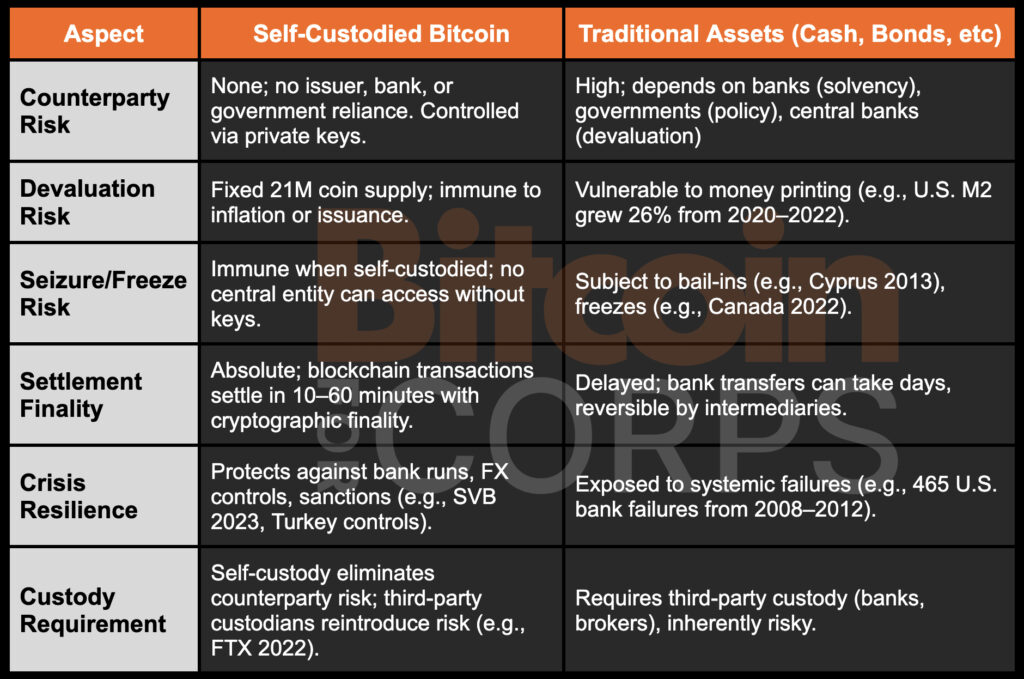Bitcoin Magazine

How Bitcoin Reduces Counterparty Risk in Corporate Treasury Strategy
Bitcoin offers corporations the rare ability to hold pure capital—an asset with no issuer, no counterparty, and no reliance on financial intermediaries. However, these benefits are fully realized only through self-custody, as third-party custodians reintroduce counterparty risk. In an era of rising systemic risk, self-custodied Bitcoin is a strategic asset for de-risking the corporate treasury stack.

Unseen Counterparty Risk in Treasury Reserves
Corporate treasury reserves are designed to ensure liquidity and stability, yet they are quietly vulnerable to systemic risks embedded in traditional financial systems. Most reserve assets—cash, government bonds, commercial paper, or money market funds—are inherently dependent on external entities:
- Banks: Corporate cash held in banks is exposed to custodial risks, including bank insolvency or operational failures. The 2008 financial crisis revealed how even “too big to fail” institutions can falter, with 465 U.S. bank failures between 2008 and 2012 alone.
- Governments: Monetary policy shifts, such as quantitative easing or interest rate hikes, can erode the real value of fiat-based reserves. Foreign exchange controls, like those imposed in Greece in 2015, can restrict access to funds.
- Central Banks: Currency devaluation through unchecked money supply growth—such as the U.S. M2 money supply increasing by 26% from 2020 to 2022—directly undermines the purchasing power of cash reserves.
These dependencies create a fragile foundation for corporate treasuries, where risks are often obscured until a crisis strikes. Bitcoin offers a structurally unique alternative: a non-custodial, non-sovereign, and non-defaultable asset that operates outside the traditional financial system. Critically, Bitcoin’s counterparty-free nature is contingent on self-custody—holding private keys directly rather than entrusting funds to third-party custodians, which reintroduce the very risks Bitcoin avoids. By adopting self-custodied Bitcoin, corporations can insulate their reserves from the failures of banks, governments, or other intermediaries, positioning it as a cornerstone for de-risking in an era of growing systemic uncertainty.
Bitcoin as Sovereign Corporate Capital
Bitcoin’s design eliminates counterparty risk at its core, but only when corporations hold their own private keys. Self-custodied Bitcoin offers unparalleled financial sovereignty, making it a transformative asset for corporate treasuries:
- No Credit Exposure: Unlike bonds or bank deposits, Bitcoin has no issuer or debtor whose default could impair its value. It exists as a decentralized protocol, secured by a global network of miners and nodes, with no single point of failure.
- No Devaluation via Issuance: Bitcoin’s supply is capped at 21 million coins, with issuance governed by a predictable, unchangeable algorithm. This contrasts with fiat currencies, where central banks can print money at will—e.g., the U.S. Federal Reserve expanded its balance sheet from $4.2 trillion in 2019 to $8.9 trillion by 2022, diluting dollar-based assets.
- No Forced Bail-Ins, Freezes, or Capital Controls: Self-custodied Bitcoin cannot be seized, frozen, or restricted by centralized authorities without access to private keys. This ensures corporations retain absolute control over their capital, even during government overreach or financial lockdowns.
- Bearer Asset with Absolute Finality: Bitcoin transactions settle on a permissionless, global blockchain with cryptographic finality, typically within 10–60 minutes. As a bearer asset, self-custodied Bitcoin grants corporations direct ownership, free from intermediaries like banks or clearinghouses.
The Self-Custody Imperative: These advantages vanish if Bitcoin is held by a third-party custodian, such as an exchange or institutional provider. Custodians reintroduce counterparty risk—e.g., the collapse of FTX in 2022 left billions in client assets inaccessible. Only self-custody, where corporations control their private keys, ensures Bitcoin’s counterparty-free status. By securing their own Bitcoin, companies can hold capital that is truly independent, immune to the failures or interventions of external entities.
Stress Test Environments That Prove the Need
Recent crises illustrate the vulnerabilities of traditional treasury assets and underscore the need for a counterparty-free alternative like self-custodied Bitcoin:
- Cyprus Bail-In (2013): To stabilize failing banks, Cyprus imposed losses on depositors, with accounts over €100,000 facing haircuts of up to 60%. Corporations holding cash in Cypriot banks were directly exposed, highlighting the risks of custodial dependence. Self-custodied Bitcoin would have been immune to such bail-ins, as no third party could access or confiscate the funds.
- Canada Trucker Protests (2022): The Canadian government froze bank accounts of individuals and businesses linked to the protests, demonstrating how quickly political actions can restrict access to funds. Corporations relying on banks faced immediate liquidity risks, while self-custodied Bitcoin would have remained accessible, transferable across borders without permission.
- SVB and Credit Suisse Collapses (2023): Silicon Valley Bank and Credit Suisse, both considered “systemically important,” faced liquidity crises that disrupted corporate depositors. SVB’s failure left thousands of businesses scrambling for access to funds, with some facing delays of weeks. Self-custodied Bitcoin, stored offline or in secure wallets, would have provided uninterrupted access to capital.
- Emerging Markets: Countries like Argentina and Turkey have imposed capital controls and FX interventions to stem currency devaluation—Argentina’s peso lost 50% of its value against the USD in 2023 alone. Corporations holding local assets faced restrictions on capital outflows, while self-custodied Bitcoin could have been moved globally in minutes, bypassing bureaucratic bottlenecks.
These events reveal a common thread: traditional reserves are only as secure as the institutions and policies behind them. Self-custodied Bitcoin, by contrast, offers a hedge against such disruptions, ensuring corporations can maintain control over their capital in even the most extreme scenarios.
Bitcoin as a Risk Mitigation Layer
Self-custodied Bitcoin serves as both a long-term store of value and a disaster hedge, offering corporations a robust tool for risk mitigation:
- Dual-Purpose Asset: Bitcoin’s historical price appreciation—averaging 100% annualized returns from 2013 to 2023—makes it a compelling store of value, while its decentralized nature protects against systemic failures. This dual role allows treasuries to preserve purchasing power while hedging against crises.
- Highly Portable Capital: Bitcoin can be transferred globally with minimal fees and no reliance on banks or payment processors. For example, a corporation could move $10 million in Bitcoin across borders in under an hour, compared to days or weeks for traditional wire transfers, which are subject to SWIFT delays or sanctions.
- Black Swan Protection: Bitcoin insulates treasuries from bank runs, currency devaluations, sanctions, or capital controls. During Venezuela’s hyperinflation (peaking at 1.7 million% in 2018), Bitcoin became a lifeline for businesses to preserve value and transact internationally. Self-custody ensures these protections are not compromised by third-party failures.
- Resilient Growth: By allocating a portion of reserves to Bitcoin, corporations can balance resilience with growth. Unlike gold, which offers stability but limited liquidity, Bitcoin combines hedge-like properties with the ability to deploy capital dynamically during crises.
Self-Custody as the Foundation: These benefits depend on self-custody. Third-party custodians, such as exchanges or crypto platforms, expose Bitcoin to the same risks as traditional banks—e.g., Mt. Gox’s 2014 collapse lost 850,000 BTC for clients. By using hardware wallets or multi-signature setups, corporations can ensure their Bitcoin remains counterparty-free, maximizing its risk-mitigation potential.
Operational Integration
Integrating self-custodied Bitcoin into a corporate treasury requires careful planning but is increasingly feasible as infrastructure matures:
- Custody Strategies: Self-custody is non-negotiable for eliminating counterparty risk. Corporations can use hardware wallets (e.g., Ledger or Trezor) or multi-signature setups requiring multiple private keys to authorize transactions, enhancing security. For larger firms, enterprise-grade self-custody solutions, like those offered by Casa or Unchained Capital, provide robust key management without third-party dependence. Institutional custodians, while convenient, reintroduce counterparty risk and should be avoided for maximum resilience.
- Evolving Standards: The ecosystem for corporate Bitcoin adoption is maturing. Audit firms like Deloitte and PwC now offer crypto-specific reporting frameworks, while insurance products for self-custodied Bitcoin (e.g., Coincover’s theft protection) are emerging. These tools help corporations meet regulatory and compliance requirements while maintaining sovereignty over their assets.
- Strategic Deployment: Bitcoin can be held passively as a reserve asset, appreciating over time, but activated during crises—e.g., to settle international payments when banks are frozen or to hedge against currency devaluation. For example, during Turkey’s 2022 lira crisis, firms using Bitcoin preserved value while fiat-based competitors faced losses.
- Board Governance: Corporations should establish clear policies for Bitcoin’s role in the treasury. This includes board-approved thresholds for allocation (e.g., 5–10% of reserves), triggers for deployment (e.g., banking crises or FX restrictions), and protocols for secure key management. Regular stress-testing of custody processes ensures preparedness.
By prioritizing self-custody, corporations can integrate Bitcoin as a strategic asset while preserving its counterparty-free advantages, balancing innovation with operational discipline.
Conclusion
Corporate treasuries are trained to diversify across asset classes, but few scrutinize the counterparty risks embedded in every traditional reserve. Cash depends on banks, bonds on issuers, and currencies on central banks—all of which can fail or intervene in ways that erode value or access. Bitcoin, when self-custodied, stands alone as an asset that requires no trust in intermediaries, only in cryptographic math.
Self-custodied Bitcoin is not a replacement for cash or bonds but a parallel asset that de-risks the capital stack. It offers corporations a hedge against systemic failures, from bank runs to capital controls, while preserving long-term growth potential. As systemic risks grow—evidenced by banking crises, geopolitical freezes, and currency devaluations—Bitcoin’s role as a treasury asset becomes undeniable. For companies seeking to future-proof their balance sheets, self-custodied Bitcoin is not just a tool—it’s a paradigm shift toward true financial sovereignty.
Disclaimer: This content was written on behalf of Bitcoin For Corporations. This article is intended solely for informational purposes and should not be interpreted as an invitation or solicitation to acquire, purchase, or subscribe for securities.
This post How Bitcoin Reduces Counterparty Risk in Corporate Treasury Strategy first appeared on Bitcoin Magazine and is written by Nick Ward.




